So I'm just back from a great trip to Cambodia with my wife. We also visited Singapore, as there is no direct flight to Cambodia from Bangalore. Singapore is a nice but touristy place; and I will pen a blog about it soon, but the experience in Cambodia is definitely worth sharing first!
One Night in Phnom Penh
Most tourists travel to Cambodia with the intention of visiting Angkor Wat, and other popular temples and monuments in Siem Reap. However, our itinerary was such that we had to spend a night in Phnom Penh. This was primarily due to the fact that buses in Cambodia do not run between Phnom Penh and Siem Reap in the late evenings. What seemed like a forced stay, became quite a pleasant experience, as we had time for a "Sunset adventure cruise" on the Mekong river. For a fee of 15 US dollars, a small diesel-powered boat took us around the banks of the river for a great view, plus a drink included.
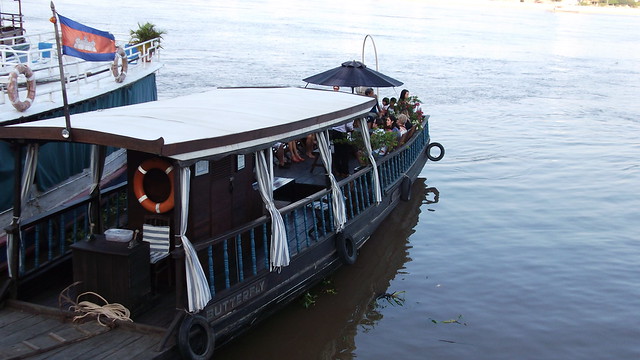 |
| The boat |
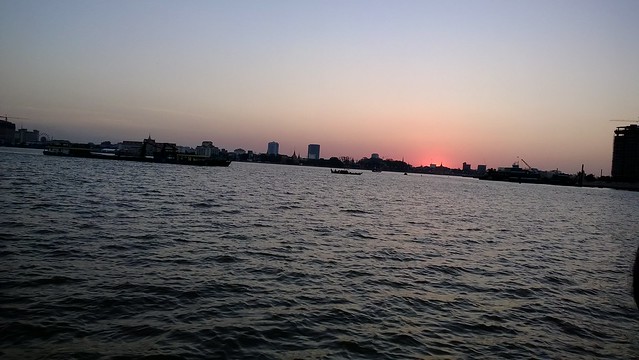 |
| Sunset on the Mekong |
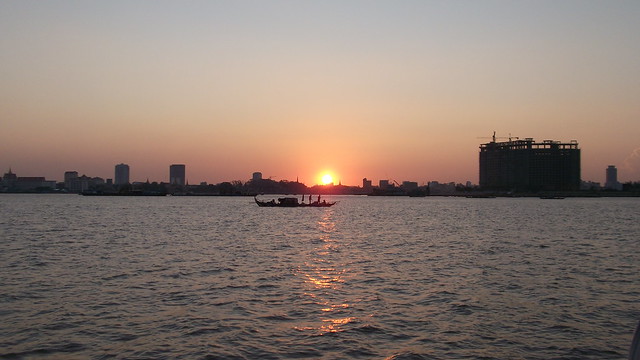
Getting to Siem Reap
We had booked on the Giant Ibis bus from the hotel. The company (Giant Ibis) was highly recommended, as they have new buses, and their drivers drive safely. The buses have WiFi, but they also have iPad veiling data-hogging tourists who devour and shred the bandwidth to pieces. Throughout the trip, I preferred using 3G data (I had bought a 2.5GB data SIM at Phnom Penh airport).
During the journey, I realized why buses do not operate after dark here. The highway between Phnom Penh and Siem Reap (as are most roads in Cambodia) is a 2 lane road, which is not well lit. While most drivers in Cambodia drive safe, there are a few who are rash, and these few - combined with the lack of proper lighting - make it unsafe to drive at night. The bus took a total of 7 hours to reach Siem Reap. It included one small break at a roadside restaurant, and a longer stop at a bigger restaurant, named "The Banyan Tree".
Angkor Wat - The City That Is a Temple
Angkor Wat is, of course, the most famous monument in Cambodia. It's on their flag, their currency notes, and even their beer! The name "Angkor" is a corruption of the Khmer word "Nokor", which, in turn is derived from the Sanskrit "Nagara". "Wat" means a temple, so Angkor Wat literally means "City Temple", or a better translation, "The City that is a Temple".
The temple was built around 1150 AD as a Hindu temple dedicated to
Vishnu. As with other temples in the Angkor region, the central towers
represent the mythical Mount Meru. Mount Meru has many myths and legends
associated with it in Hindu culture. One of these is that when Manu was
warned of the Great Flood by the fish-avatar of Vishnu, he built a boat
(similar to Noah's Ark), and navigated the flood waters to reach Mount
Meru.
 |
| Angkor Wat at sunrise. |
We visited the temple at 5AM to catch the sunrise, hoping to beat the crowds. However, the place was teeming with tourists, all waiting with their cameras to catch the sun rising over the temple's towers.
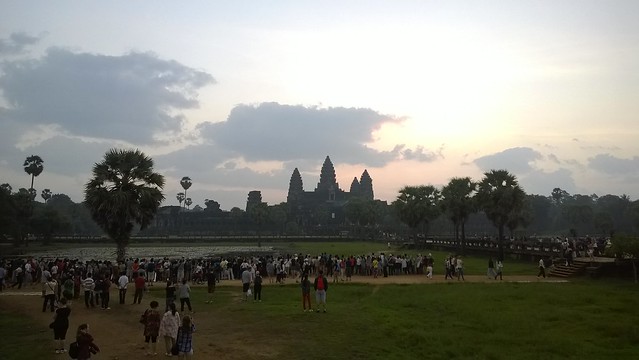
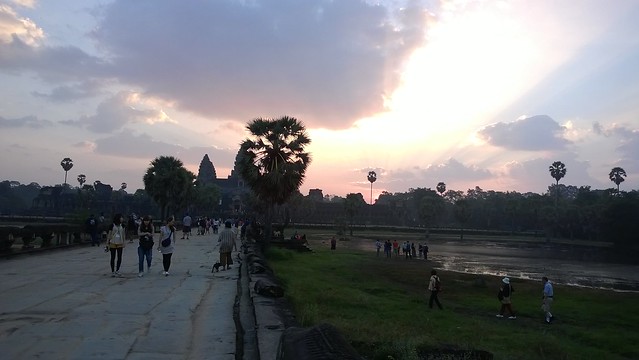 |
| Even at dawn, the place is teeming with people! |
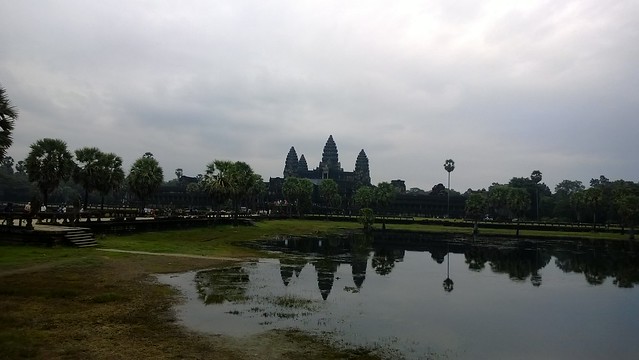 |
| A clearer view of the temple |
The walls inside the temple has carvings depicting the Ramayan & Mahabharata. The wall with the Ramayan carvings depict scenes from the battle of Lanka. In the picture below, Ram is on Hanuman's shoulders, firing an arrow at Raavan, while Lakhsman and Vibheeshan look on.
 |
| The battle of Lanka. Ram on Hauman's shoulders. |
|
Yet another wall depicts another scene from Hindi mythology, the "Samudra Manthan", or churning of the ocean. Although there are some differences in the Cambodian interpretation of this story, for example, Vishnu is shown as churning the ocean, while in the Indian legend, it is Shiva, if I am not mistaken.
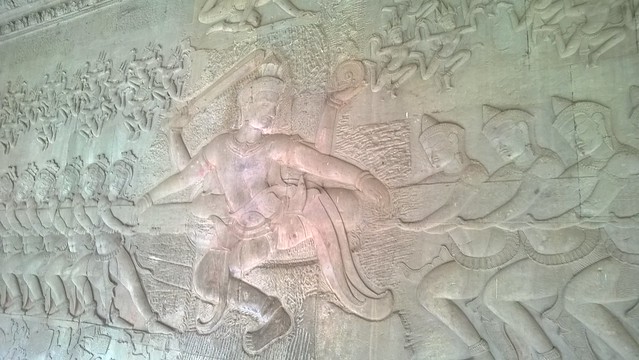 |
| Samudra-Manthan |
Inside the temple, there are about three levels. The first with these wall carvings, an altar, and a "Hall of a Thousand Buddhas". At this point, maybe I can mention that although this was a Hindu temple
originally, it was later converted to a Buddhist one. In fact, in one
of the statues here, you can see the Buddha sitting on a seven-headed
snake. This points to the possibility that (maybe) the statue originally
depicted Vishnu, and was later modified to represent The Buddha.
 |
| Main Altar in the first level. |
The second level is a open-air courtyard which leads to the towers of the temple, while the third and final level is when you ascend these towers.
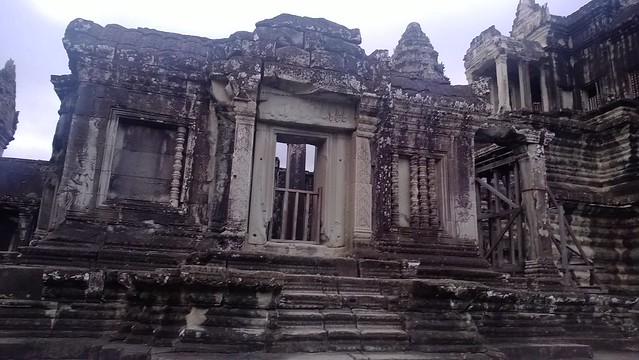 |
| The second level courtyard. |
|
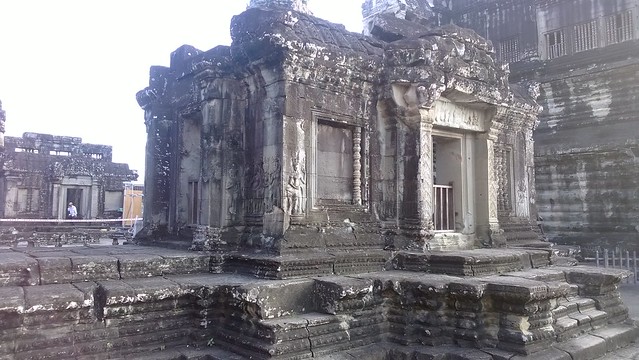 |
| Carvings of Apsaras on the second level. |
The third level has a dress-code - both men and women need to have
their shoulders and knees covered (although knee length shorts seem to
be acceptable). There is a staircase which is quite steep, and opens up only around 7:45AM. We had to wait in the second level for sometime before the temple authorities allowed us to ascend.
 |
| View of the towers from the second level. |
|
|
|
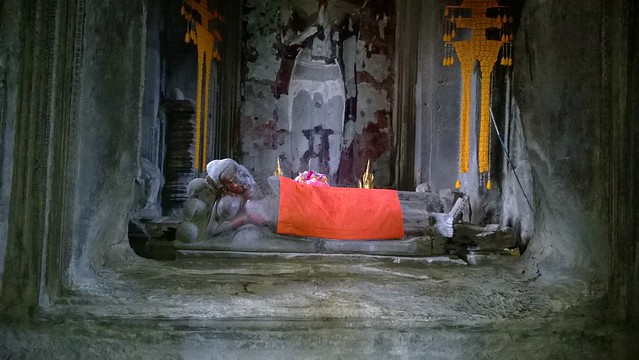 |
| Shrine of reclining Buddha. |
|
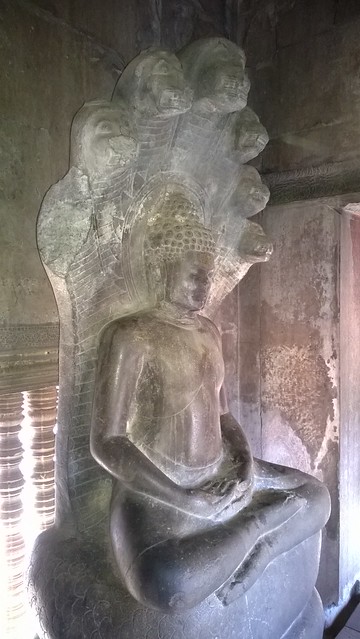 |
| Statue of Buddha sitting on a seven-headed snake. This probably represented Vishnu earlier. |
|














